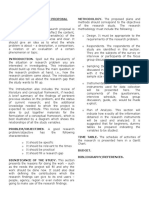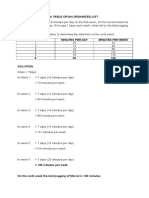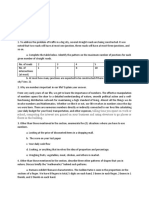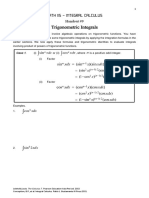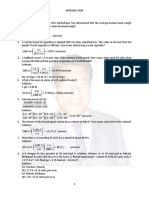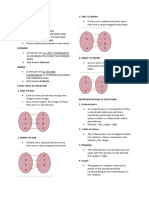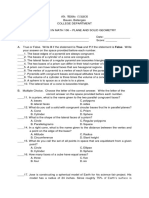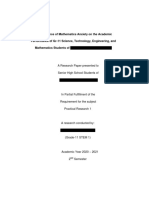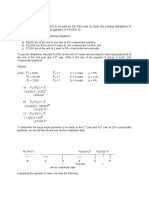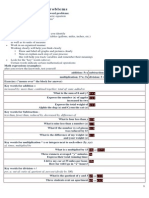Problem 16 A salesman sold twice as much pears in the afternoon than in the morning.
If he
sold 360 kilograms of pears that day, how many kilograms did he sell in the morning and how
many in the afternoon?
Solution:
Let x be the number of kilograms he sold in the morning. Then in the afternoon he
sold 2x kilograms. So, the total is x+2x=3x. This must be equal to 360.
3x = 360
x = 360/3
x=120
Therefore, the salesman sold 120 kg in the morning and 240 in the afternoon.
Problem 17 Mary, Peter, and Lucy were picking chestnuts. Mary picked twice as much
chestnuts than Peter. Lucy picked 2 kg more than Peter. Together the three of them picked 26
kg of chestnuts. How many kilograms did each of them pick?
Solution:
Let x be the amount Peter picked. Then Mary and Lucy picked 2x and x+2 respectively. So
x+2x+x+2 = 26
4x = 24
x= 6
Therefore, Peter, Mary, and Lucy picked 6, 12, and 8 kg, respectively.
Problem 18 Sophia finished 2/3 of a book. She calculated that she finished 90 more pages
than she has yet to read. How long is her book?
Solution:
Let x be the total number of pages in the book, then she finished
(2/3 ⋅ x) pages. Then she has x - 2/3⋅ x = 1/3 ⋅ x pages left.
(2/3) ⋅ x – (1/3) ⋅ x = 90
(1/3) ⋅ x = 90
X= 270
So the book is 270 pages long.
Problem 19 A farming field can be ploughed by 6 tractors in 4 days. When 6 tractors work
together, each of them ploughs 120 hectares a day. If two of the tractors were moved to
another field, then the remaining 4 tractors could plough the same field in 5 days. How many
hectares a day would one tractor plough then?
�If each of 66 tractors ploughed 120 hectares a day and they finished the work in 44 days, then
the whole field is: 120 ⋅ 6 ⋅ 4 = 720 ⋅ 4 = 2880 hectares. Let's suppose that each of the four
tractors ploughed x hectares a day. Therefore in 5 days they ploughed
5⋅4⋅x=20⋅x hectares, which equals the area of the whole field, 2880 hectares.
So, we get 20x = 2880
x = 2880/20 = 144. Hence, each of the four tractors would plough 144 hectares a day.
Problem 19 A student chose a number, multiplied it by 2, then subtracted 138 from the result
and got 102. What was the number he chose?
Solution:
Let x be the number he chose, then
2⋅x−138=102
2x =240
x =120
Problem 20 The first year, two cows produced 8100 litres of milk. The second year their
production increased by 15% and 10% respectively, and the total amount of milk increased to
9100 litres a year. How many litres were milked from each cow each year?
Solution:
Let x be the amount of milk the first cow produced during the first year. Then the second cow
produced (8100−x) litres of milk that year. The second year, each cow produced the same
amount of milk as they did the first year plus the increase of 15 % or 10%.
�Problem 21 The distance between stations A and B is 148 km. An express train left station A
towards station B with the speed of 80 km/hr. At the same time, a freight train left station B
towards station A with the speed of 36 km/hr. They met at station C at 12 pm, and by that time
the express train stopped at at intermediate station for 10 min and the freight train stopped
for 5 min. Find:
a) The distance between stations C and B.
b) The time when the freight train left station B.
Problem 22 Susan drives from city A to city B. After two hours of driving she noticed that she
covered 80 km and calculated that, if she continued driving at the same speed, she would end
up been 15 minutes late. So she increased her speed by 10 km/hr and she arrived at city B 36
minutes earlier than she planned. Find the distance between cities A and B.
�Problem 23 To deliver an order on time, a company has to make 25 parts a day. After making
25 parts per day for 3 days, the company started to produce 5 more parts per day, and by the
last day of work 100 more parts than planned were produced. Find how many parts the
company made and how many days this took.
Problem 24 A car left town A towards town B driving at a speed of V = 32 km/hr. After 3
hours on the road the driver stopped for 15 min in town C. Because of a closed road he had to
change his route, making the trip 28 km longer. He increased his speed to V = 40 km/hr but
still he was 30 min late. Find:
a) The distance the car has covered.
b) The time that took it to get from C to B.
�Problem 25 If a farmer wants to plough a farm field on time, he must plough 120 hectares a
day. For technical reasons he ploughed only 85 hectares a day, hence he had to plough 2 more
days than he planned and he still has 40 hectares left. What is the area of the farm field and
how many days the farmer planned to work initially?
Solution:
Let x be the number of days in the initial plan. Therefore, the whole field is 120⋅x hectares.
The farmer had to work for x+2 days, and he ploughed 85(x+2) hectares, leaving 40 hectares
unploughed. Then we have the equation:
120x=85(x+2)+40
35x=210
x=6
So the farmer planned to have the work done in 6 days, and the area of the farm field is 120⋅ 6
= 720 hectares.
WORD PROBLEMS FROM:
https://www.math10.com/en/algebra/word-problems.html




